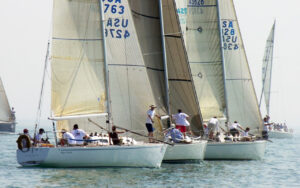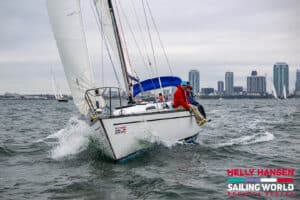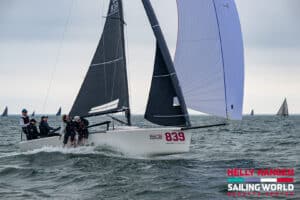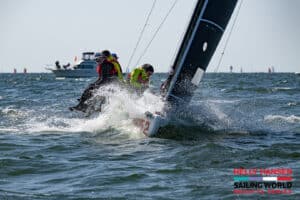
Antigua Feature
When the PRO of the 32nd America’s Cup writes in the Notice of Race, “Wednesday’s racing is scheduled to be conducted . . . with the emphasis being on fun and frolic . . . ” you know you’re not in Valencia anymore. Nor in Chicago, St. Petersburg, or San Diego for that matter. When you meet Peter Reggio (a.k.a. “Luigi”) at the skippers meeting, and he’s barefoot and calling for a day of relay racing in 12-foot dinghies, it’s time for an attitude adjustment.The top dogs from each of the nine 2005 Lands’ End NOOD regattas came to Sunsail’s Club Colonna on Antigua last winter for the first Caribbean NOOD Rendezvous. Having earned their stripes in a variety of keelboat classes, they now faced unfamiliar equipment and easterly trades that were blowing the sand off the beach. Luigi responded to the 30-knot winds by pulling nine injection-molded Topper Topaz dinghies from the club’s armory of boats, and setting a reaching course 150 yards out of the harbor and back. Teams of three sailed their boat in succession, beginning with an exciting LeMans start. Easy as it sounds, tacking around the offshore mark was a hit-or-miss event, and boat exchanges were entertaining, especially for the spectators. Afterwards, a few sailors were willing to go on the record about their inversions:”I took a couple of detours,” said Bob Broderick, J/105 crew on Damian Emery’s Larchmont team. “Once the boat turtled, it wasn’t easy reaching the daggerboard.””The shark at the mark was huge,” complained David Wolanski, of David Holme’s Detroit winner, a Cal 25. “He knocked my bow over, and then I capsized.”Technique, as always, was important: One skipper had his board up a little too far on the broad reach and was swept up on the breakwater in front of the resort’s lunch crowd. Another team gave its boat such a big push off the beach that the skipper toppled overboard, and the Topaz gradually sailed out of the harbor with him swimming in its wake. Richard Reid, Beneteau 36.7 champ from Toronto noted, “The ‘dogs off the chains’ breeze left many an ego shredded to bits, but hey it’s just a race.”With the wind down to 25 knots the next day, Luigi rolled out the Sport 16s, a British design that three could sail. These were sailed without their asymmetrics, so this was collegiate-style racing. The following day, with the wind a mere 20 knots (and the Sport 16s nursing a few wounds) it was the Hobie 15s, a European-built, boardless fiberglass catamaran that sails quite well and punishes the inattentive with an occasional pitchpole. For the wrapup, in 10 to 15 knots, the Sport 16s were sailed with spinnakers.Each day of racing occupied only a couple of hours, so sailors could sleep late, go for a bike ride, windsurf, read a book, go into St. John’s, and gain as much weight as they wanted at the buffet. Emery’s Larchmont team joined the Club’s waterfront staff at local watering holes in St. John’s, and made the mandatory 2 a.m. stop at the local bakery for fresh bread.Meantime, the Toronto team staged an epic evening of Texas hold ’em. This poker game had a lot of sugar on the table, and it turned out there was a professional in the group. Or maybe he was the only sober one. In any case, Luigi went home with his pockets stuffed with most of Club Colonna’s sugar packets. Although he didn’t play poker, it was Detroit’s Holme who hit the jackpot: his seven-year-old son Jack had such a good time that he asked if he could trade next year’s trip to Disney World for a return trip to Club Colonna.When it was all said and done, the Melges 24 sailors who’d triumphed in St. Pete stole the show. Chicago, Marblehead, and Detroit winners followed, respectively, and then came Toronto, San Diego, Texas, and Larchmont-all of whom stepped off the island determined to work on their dinghy techniques.









